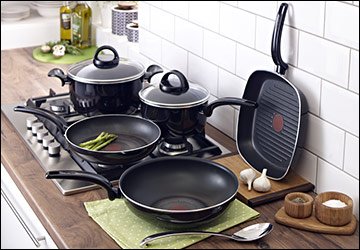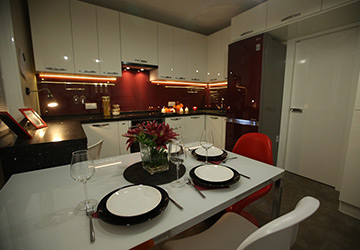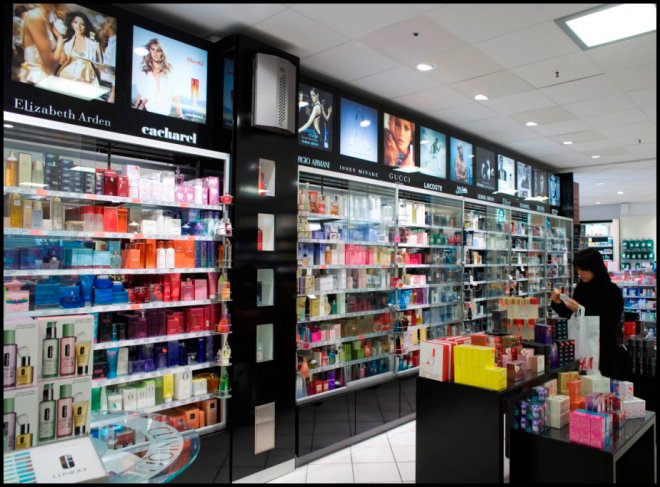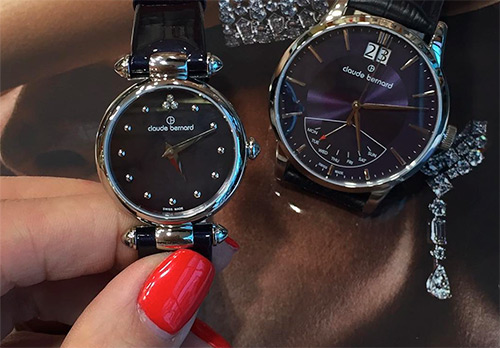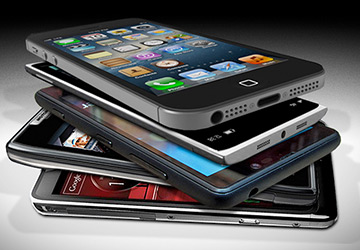BLOG
Pans with teflon and ceramic coating
I like to cook, for myself and my own girlfriends, friends, and besides, I love good things, so I was puzzled by the choice of a frying pan. I bought new pans in the store, read information on various forums. Along the way, I cooked in different pans, being away and on vacation. As a result, in recent years, I managed to find out and test in practice, more than a dozen different pans.
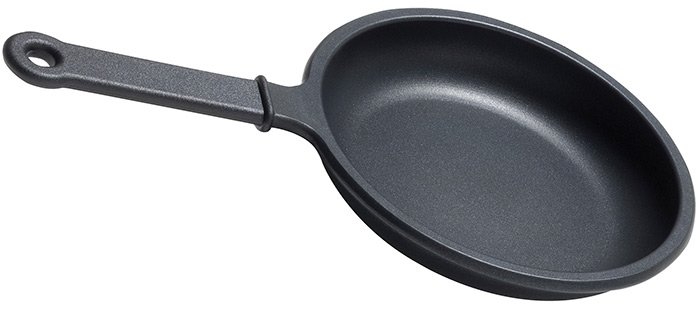
I had to use Teflon-coated pans, ceramic-coated pans, cast iron, stainless steel, aluminum, and even titanium. Which pan is better, which one to choose and buy?
In general, is it possible to have 1 frying pan for all occasions, the best? It all depends on how much you cook and what exactly you cook. If a frying pan is used very rarely, in order to fry sausages or scrambled eggs, it is quite possible to do with one frying pan. Which one? In case of rare use, I advise you to buy a Teflon-coated pan with a diameter of 26 centimeters, of the highest quality. Choose pans of the highest price range, there will be no worries with them. Why such advice?
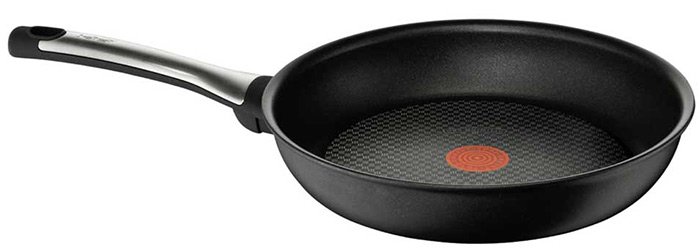
Quite simply, Teflon-coated pans can be harmful. Rather, by themselves at rest, when they are on the shelf, there is no harm from them, but when they are put on the fire, the most interesting begins. The coating is slowly but surely breaking down, and all the elements contained in the Teflon coating get into the food. What exactly are the elements there? The composition of the Teflon coating of frying pans includes many different elements, which of them affect how quickly the body will be harmed, it is unrealistic to predict. Someone can use cheap Teflon-coated pans all their lives and live in good health to a ripe old age, while others are less fortunate.
In addition, studies have shown that the effects of cooking in Teflon pans can affect not only you, but also your offspring. The harmful effects of Teflon pans have been proven, this is not a myth, but a confirmed fact.
Why, then, would I recommend buying Teflon-coated pans? Note that I only give this advice to those who cook very rarely. In addition, I advise you to buy the most expensive pans. If you cook a couple of times a month and use the most expensive and high-quality frying pan, it won't harm your health. And if your life will not be long, then it is definitely not the fault of Teflon. There are so many harmful things in the life of a modern person. For example, it's funny to hear stories about the dangers of Teflon from people who regularly smoke cigarettes, drink beer and eat convenience foods. The same sausages and sausages, much more harmful than a frying pan.
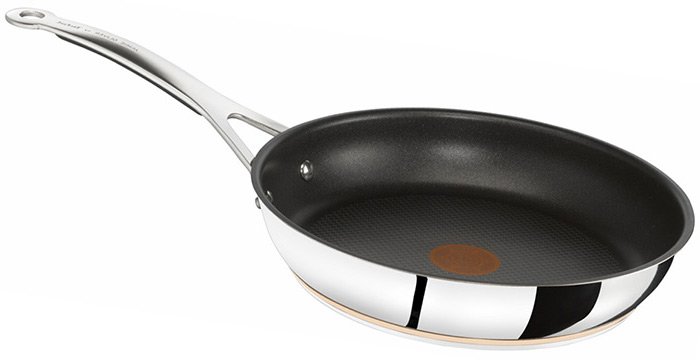
In addition, I want to note that Teflon pans will last longer and, accordingly, their coating will be more intact, if you handle them carefully, use special scoops for cooking and wash them carefully. They do the greatest harm when cooking at high temperatures, the more you heat the pan, the faster the coating breaks down and the more elements will evaporate during the cooking process.
True, Teflon pans also have advantages. No frying pan can match the Teflon frying pan for ease of cooking and washing. Absolutely nothing sticks or burns to a quality Teflon-coated pan. It is a pleasure to cook on it, you do not have to scrape off the stuck piece, and the cutlets will not fall apart. And when you start washing the pan, you need a drop of detergent and literally one minute of time. After that, the pan can be wiped off and sent to the shelf, where it will look like new.
Conclusion: You can buy and use Teflon-coated pans if you rarely cook. You need to buy the most expensive and high-quality ones, their coating is much stronger and more durable, and, accordingly, there will be less harm. If you use a Teflon frying pan 1-2 times a month, choose the most expensive one, it will last for 15 years, at least.
Cast iron and ceramic coated pans
If cooking and using a frying pan is a regular activity, it is best to purchase several frying pans for specific tasks.
Frying pans with ceramic coating
They are considered the most environmentally friendly, harmless to health. Ceramics withstands high temperatures, does not emit any harmful elements. Buying a new ceramic coated pan is a real pleasure. Choose the most expensive ones, made of die-cast aluminum, with thick walls and an even thicker bottom. Stamped pans are lighter and cheaper, but they are of inferior quality and are more difficult to cook with them, and besides, they serve less.
The lifespan of the ceramic-coated frying pan, its weak point. Regardless of the thickness of the walls and bottom, they are much inferior to Teflon.
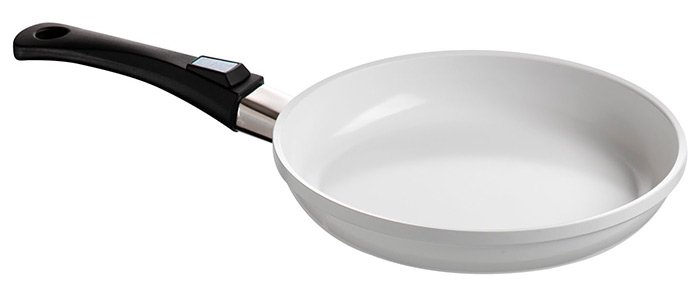
Why do they have a short lifespan? Ceramics is harmless, it is not afraid when stirring with a metal spoon, but it is powerless against any other threat. Temperature changes destroy any ceramics and stone, natural or artificial porcelain stoneware, it doesn't matter. When we put a ceramic-coated pan on the fire, it heats up. Then they put chunks of cold fish in the pan, maybe even from the freezer, or break a few eggs that have just been taken from the refrigerator. The temperature difference between ceramics and food is destructive to the ceramic coating. Conduct an experiment, pour boiling water into a jar, then pour and pour cold water. The can will almost certainly crack or collapse altogether.
The ceramic coating of pans is more durable and the pan will not fall apart or even crack, but micro cracks on its surface will appear after each cooking. As a result, each time it loses its non-stick properties. Food will stick more and more, and it is more difficult to wash such a pan each time.
Using it every day, literally in 2-3 months you will notice a significant deterioration in non-stick properties. The fish will stick and the pieces will start breaking. I personally was a little offended to observe such changes in the cooking process in a frying pan, bought for almost 2,000 rubles.
Sadly, but it is a fact - frying pans with ceramic coating do not please their housewives for long. Is it possible to extend their service life?
It is possible, but for this you will have to observe a number of rules that will not always have a good effect on the quality of the finished dishes. Put the pan on fire and without letting it heat up, immediately load it with food, preferably at room temperature. In this case, the temperature difference will be less, therefore, the ceramics will not suffer so much. For example, when I make an omelet, I first heat the milk in a ladle and then beat the eggs in it. When everything is ready, I put the pan on the fire and fill it immediately. Such a gentle cooking mode is far from always suitable, because in many cases, in order to get the desired result, food must be sent to a hot frying pan.
Conclusions: pans with ceramic coating are the most environmentally friendly, but their age is very short. If you cook every day, then even a year will not be enough, and this is taking into account the purchase of a frying pan for 2000 rubles!
In that case, are cast iron pans the best buy? Let's try to figure out what are their advantages and disadvantages? Cast iron pans are the most durable, they do not have a special coating that is destroyed irrevocably. Cast iron pans have their own specific coating, which is easy to restore.Cast iron is a porous metal, it absorbs oil and fat, due to which an oil film forms on the surface, it protects the pan from burning. Of course, they cannot be compared with Teflon ones, nothing sticks to them in principle, but they still stick to cast iron ones, but they are easily separated, without the breakdown of pieces. Therefore, the fish can be fried in a cast-iron pan, keeping the pieces intact. True, this result is guaranteed if the pan is used correctly.
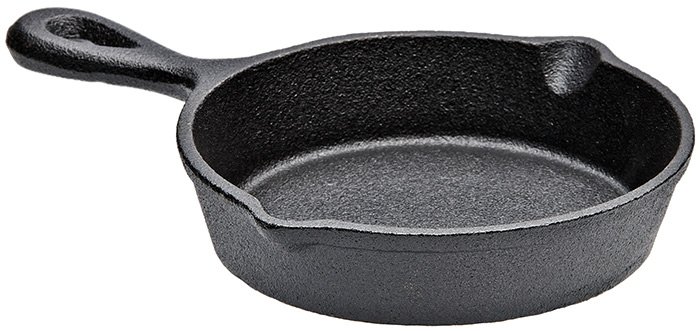
So cast-iron pans are the perfect solution? Everything is not as simple as it seems at first glance. It is necessary to cook cutlets in a large frying pan, because rarely does anyone fry 2-3 cutlets, usually they make more, which means that a large frying pan is needed. The weight of a large cast-iron frying pan, taking into account the cutlets, will be very noticeable; for many, this weight will discourage any desire to cook. Further, one more minus - the cast-iron pan is well washed and nothing sticks to it, only if it is used correctly. Cook often, preferably every day or every other day. After cooking, let the pan cool. Then it is washed, but not with detergents, since they will destroy the protective oil coating, but with soapy water. After washing, wipe the cast-iron pan dry and pour a couple of tablespoons of oil, or rub it with oil. In this form, she is waiting for the next cooking.
If you do not follow the above rules, a cast-iron pan will give a lot of unpleasant impressions, fish and anything else will stick to it, it will not wash well. If at such a moment you take it and wash it thoroughly, and then do not grease it with oil, it will be covered with rust. For the appearance of rust, you do not have to wait a month, literally in 2-4 days, an unused and uncoated frying pan will begin to rust.
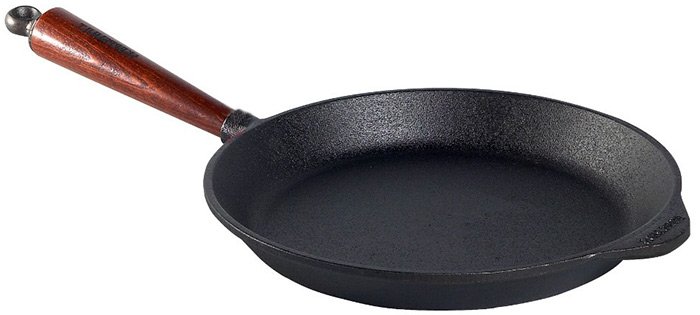
Conclusions: cast-iron pans are the most durable, they can last for decades, be passed on from grandmothers to granddaughters and beyond. But the operation of a cast iron pan requires careful adherence to the rules. Taking into account the fact that it should always be oiled inside, and it is better that the oil is poured in the amount of 1-3 tablespoons, it cannot be hidden in the cupboard, other pans cannot be put into it one into the other. You will always have to keep a cast-iron pan on the stove, washed, dried, filled with oil and covered with a lid. It turns out that such an assistant in the kitchen is only suitable for a professional chef or a very hardworking housewife. Lazy housewives may not even think about cast iron pans.
I also want to note, do not buy cast-iron pans covered with enamel, these are the most useless items in the kitchen and thrown away money. With regard to cost, the price range is very large. Cast iron pans from European manufacturers - Sweden, France, Switzerland, have a significant cost of 3000-6000 rubles, more expensive options are possible. Russian and Chinese pans cost 500-1200 rubles.
In the production of cast-iron pans, it is not necessary to use innovative technologies and expensive equipment. Cast iron is a cheap material, so cast iron pans made in Russia and China are in no way inferior to European ones. There is no point in paying for the brand, because in this case you do not gain anything, the frying pan will not be different. A Swedish frying pan will not have better quality, nor will it have better design. Cast iron pan, this is not a Louis Vuitton bag, which means there is nothing to overpay.
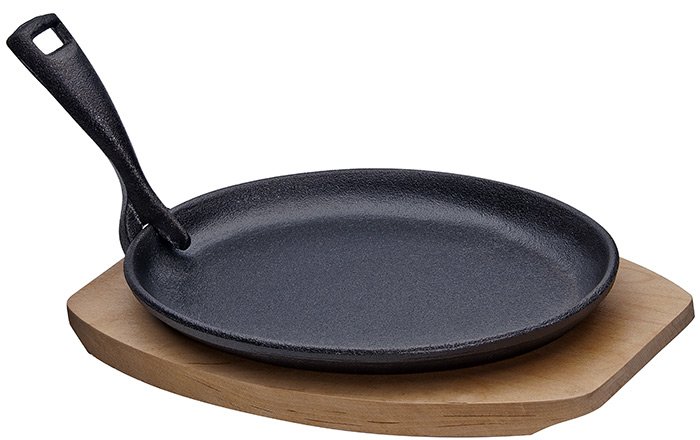
Conclusion - which pan to choose and buy for our kitchen?
For those who regularly cook, carefully monitor their health, and want all products to be environmentally friendly, we make the following choice:
Frying pan 1 for frying fish, cutlets, chops, and other dishes in large quantities, you need to buy a large 28-30 centimeters, a frying pan with a ceramic coating. When buying, we choose the one with the thickest walls and bottom. With proper operation, it will last for a year, then it must be changed.
Frying pan 2 for frying scrambled eggs and everything that is cooked in small volumes, for 1-2 people. I advise you to buy a cast iron 20 centimeters.With this diameter, the weight of a cast-iron pan is acceptable and you can really wash it on your own. If you follow the above rules, it will last a lifetime and remain for posterity.
Frying pan 3, in the process of cooking borscht, it is required to fry and stew a sauce made from sour products - slightly fried onions, tomato paste or fresh, barrel tomatoes, beets, carrots. This sauce requires a separate pan. Large, with a ceramic coating is too large, it is better not to touch it for the sake of cooking the sauce, because it is most difficult to wash, and the service life decreases from time to time, so we save it for cutlets and fish. A cast-iron pan is also not good, the acid in tomatoes destroys the oil coating in one cooking, after which everything sticks to it, it is difficult to wash it. With such a frying pan, you have to carry out the procedure for restoring the oil coating, and this is a significant waste of time.
So for sour sauces and gravies, we use the third pan. I personally use teflon coated. If you choose the most expensive one, with thick walls and high-quality Teflon, it will not be harmful. Rather, its harm will be scanty, less noticeable than the result of secondhand smoke. We do not cook sour gravies and sauces every day, in addition, it is better to cook them with the lid closed, therefore, there is a process in which the products are stewed, not fried. During such cooking, the temperature in the pan is much lower than during frying, therefore, the Teflon does not break down or evaporate.
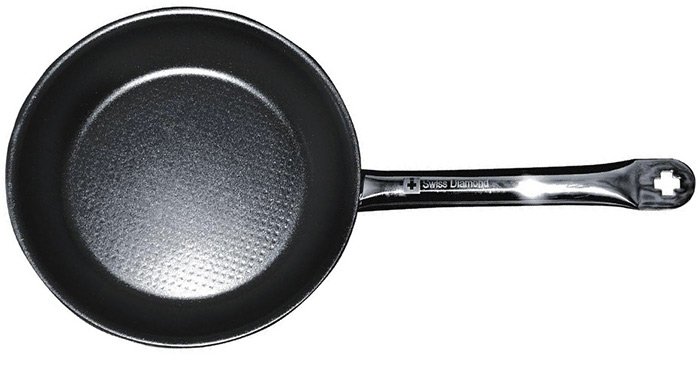
A small teflon pan for sour sauces will last over 10 years. Replace when you notice small scratches on the surface.
For those who do not trust Teflon at all, it remains to advise a small frying pan with a ceramic coating - you will have to change it every year or more often. Or you can purchase a frying pan made of stainless steel and in some cases titanium.
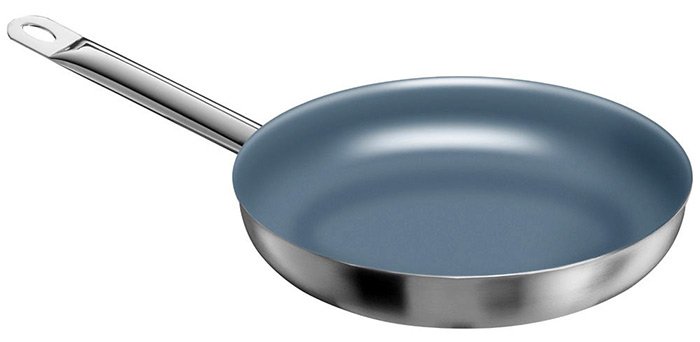
I don't see any point in dwelling in detail on pans made of stainless steel and titanium for some reason. Titanium pans are extremely rare, in addition, they are really expensive for most housewives. Stainless steel pans aren't cheap either. These are those made of food grade steel, not cheap items of unknown origin. By describing how to tell good stainless steel from bad stainless steel, our article will expand to the size of an entire brochure. Therefore, I advise those who do not believe in Teflon at all to use exclusively ceramic-coated pans. Choose the most expensive ones, and as soon as the products begin to stick to them, change them to new ones. Regular expenses for the purchase of new pans is the only disadvantage of the ceramic coating, in all other respects there are only advantages. Environmentally friendly, while new, nothing sticks to them, easy to clean. They look beautiful when washed and do not spoil the look of the kitchen.
Related video - how to choose and buy a frying pan. (Not everyone wants to voice the fact that pans with a ceramic coating have, in addition to their advantages, a short service life.)
As you can see, there is no perfect frying pan; they all have their pros and cons. Which one to choose and buy is up to you, based on your preferences and capabilities.
Comments and Reviews
Add a comment
Rating news
Shades of clothing that make women look younger
What shades of hair make women younger: rules and photos
Funny wedding dresses - photos and ideas
12 most expensive down jackets for the winter
How to look 25 at 40: tips from supermodels
Beautiful schoolgirls
Anti-aging haircuts and hairstyles for women
Fashionable skirts for autumn and winter
Fashionable women's trousers for the cold season
Fashionable and stylish sandals for summer 2024
Spring-summer 2024
 Fashionable dresses and tops with thin spaghetti straps
Fashionable dresses and tops with thin spaghetti straps
 Bandana tops: how to wear stylishly and beautifully
Bandana tops: how to wear stylishly and beautifully
 How to put together the perfect men's wardrobe for the summer
How to put together the perfect men's wardrobe for the summer
 Trendy shorts for spring-summer 2024
Trendy shorts for spring-summer 2024
 Fashionable skirts for spring-summer 2024: a guide to online shopping
Fashionable skirts for spring-summer 2024: a guide to online shopping
 The most fashionable dresses spring-summer 2024: styles and colors
The most fashionable dresses spring-summer 2024: styles and colors
 Fashionable total look 2024: image ideas and trends
Fashionable total look 2024: image ideas and trends
